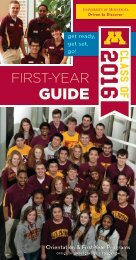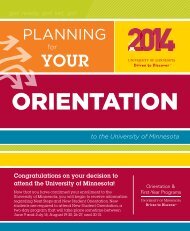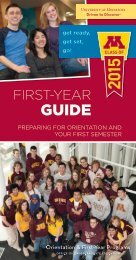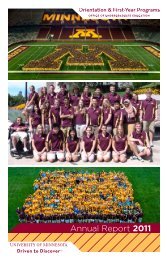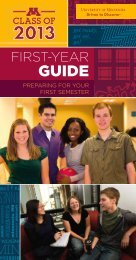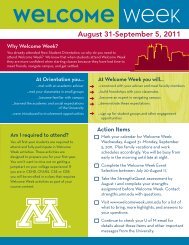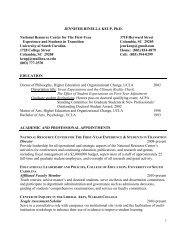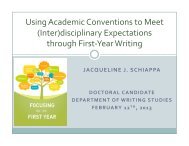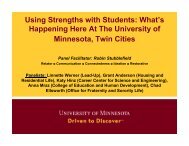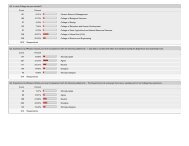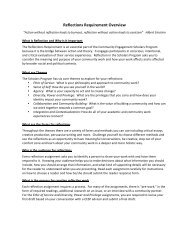The Principles of Strengths-Based Education - Orientation and First ...
The Principles of Strengths-Based Education - Orientation and First ...
The Principles of Strengths-Based Education - Orientation and First ...
You also want an ePaper? Increase the reach of your titles
YUMPU automatically turns print PDFs into web optimized ePapers that Google loves.
<strong>Strengths</strong>-<strong>Based</strong> <strong>Education</strong> 5<br />
Principle 4: Deliberate application <strong>of</strong> strengths within <strong>and</strong> outside <strong>of</strong> the classroom fosters<br />
development <strong>and</strong> integration <strong>of</strong> new behaviors associated with positive outcomes.<br />
A focus on the deliberate application <strong>of</strong> strengths within the classroom shapes the<br />
behaviors <strong>of</strong> educators <strong>and</strong> students <strong>and</strong> the nature <strong>of</strong> education in several notable ways.<br />
Specifically, educators utilizing a strengths-based stance begin by selecting pedagogical<br />
approaches that bring out their best in the educational process <strong>and</strong> seek to model how they<br />
leverage personal strengths in teaching, advising, or other domains <strong>of</strong> life. Such educators<br />
regularly discuss strengths application with students, providing personal examples or illustrations<br />
<strong>and</strong> describing some <strong>of</strong> the experiences that were critical in their own process <strong>of</strong> developing<br />
strengths.<br />
Building upon the idea that “to educate” literally means “to draw out” or “to bring forth,”<br />
strengths-based educators believe that part <strong>of</strong> their core responsibility is to draw out the strengths<br />
that exist within students by heightening students’ awareness <strong>of</strong> them <strong>and</strong> cultivating a greater<br />
future orientation around how students’ strengths might be catalyzed as they approach their<br />
education. Teaching from a strengths-based perspective requires educators to devote effort to<br />
helping students notice <strong>and</strong> identify occasions when their strengths are evident in the classroom<br />
or when they are using personal strengths to complete assignments with a high level <strong>of</strong> quality. A<br />
strengths-based educator also fosters a learning environment in which affirming peer-to-peer<br />
feedback is a regular feature, as students are taught to cultivate the skill <strong>of</strong> noting their<br />
classmates’ strengths in action. Creating opportunities for students to choose assignment types<br />
that allow them to leverage their unique strengths provides practice in selecting activities that will<br />
bring out their best.<br />
<strong>The</strong>se recommendations are resonant with the core ideas <strong>of</strong> self-determination theory,<br />
which explains that individuals function at optimal levels <strong>and</strong> are most authentically motivated<br />
when three psychological needs are met: competence, autonomy, <strong>and</strong> relatedness (Ryan & Deci,<br />
2000). Helping students underst<strong>and</strong> the connection between their strengths <strong>and</strong> their personal<br />
goals <strong>and</strong> <strong>of</strong>fering guidance in the application <strong>of</strong> their strengths in the most effective ways can<br />
elicit feelings <strong>of</strong> competence, <strong>and</strong> providing students with choices <strong>and</strong> opportunities for selfdirection<br />
can support their need for autonomy. When educators establish a learning culture where<br />
students view themselves <strong>and</strong> others through strengths-colored glasses (Clifton, Anderson, &<br />
Schreiner, 2006), they help to foster appreciation for differences, highlight the value <strong>of</strong><br />
collaboration <strong>and</strong> teamwork, <strong>and</strong> establish a powerful sense <strong>of</strong> relatedness.<br />
Principle 5: Intentional development <strong>of</strong> strengths requires that educators <strong>and</strong> students<br />
actively seek out novel experiences <strong>and</strong> previously unexplored venues for focused practice<br />
<strong>of</strong> their strengths through strategic course selection, use <strong>of</strong> campus resources, involvement<br />
in extracurricular activities, internships, mentoring relationships, or other targeted growth<br />
opportunities.<br />
Highly effective strengths educators underst<strong>and</strong> that the ultimate objective <strong>of</strong> a strengthsbased<br />
initiative is to help students consider their own responsibility in deliberately, attentively<br />
developing their strengths through practice <strong>and</strong> engagement in novel experiences. This final<br />
principle builds upon the others by suggesting that if students are to maximize their strengths,<br />
they will need to cultivate the discipline <strong>of</strong> proactively seeking new experiences that will expose<br />
them to information, resources, or opportunities to heighten their skills <strong>and</strong> knowledge about how<br />
to mobilize their strengths most effectively. This undertaking requires more than an innovative<br />
application <strong>of</strong> strengths in existing settings, but dem<strong>and</strong>s engagement in new experiences<br />
designed to exp<strong>and</strong> personal strengths.<br />
An ideal strengths-based educational model highlights the investment <strong>of</strong> effort <strong>and</strong> the<br />
creation <strong>of</strong> a strengths growth plan as critical components in a developmental process, <strong>and</strong> invites<br />
______________________________________________________________________________



